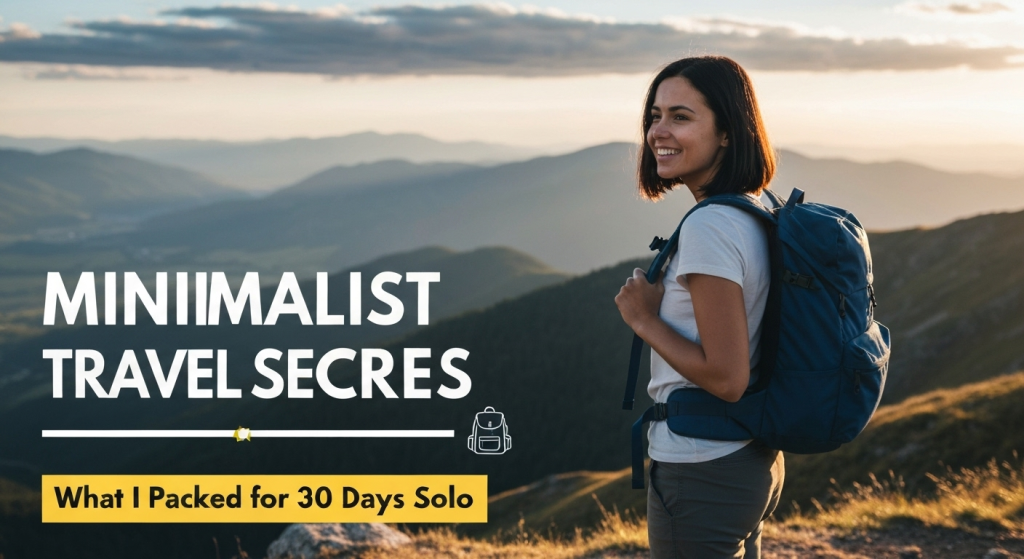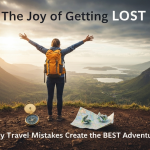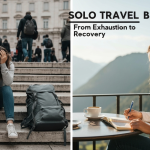Minimalist travel changed my life completely. After five years of professional travel consulting and countless solo adventures across 30+ countries, I learned that less truly means more when you’re living out of a backpack. My name is Mahnoor Farooq, and I’ve spent the last half-decade helping travelers optimize their packing strategies while exploring remote corners of the world myself.
Last month, I embarked on a 30-day solo journey through Southeast Asia with just one 35-liter backpack. The experience taught me valuable lessons about smart packing, essential items, and the freedom that comes with traveling light. This guide shares exactly what I packed, why each item earned its place, and how you can apply these principles to your own adventures.
Understanding Minimalist Travel Philosophy
Minimalist travel isn’t about suffering or missing out on comfort. It’s about intentional choices that enhance your journey rather than weigh you down. The core principle revolves around bringing items that serve multiple purposes while maintaining quality and functionality.
During my early travel days, I made every mistake possible. I packed three pairs of boots for a beach destination, brought enough clothes for two months on a one-week trip, and carried gadgets I never used. These experiences taught me valuable lessons about necessity versus convenience.
The minimalist approach focuses on versatility over quantity. Every item must justify its space and weight. This philosophy extends beyond physical belongings to mental clarity and travel flexibility. When you’re not constantly managing stuff, you can focus on experiences and connections.
Research shows that decision fatigue affects travelers who pack too many options. Psychology Today reports that limiting choices actually increases satisfaction and reduces stress levels. My clients consistently report feeling more relaxed and spontaneous when following minimalist packing principles.
Benefits of Minimalist Backpack Travel
| Benefit | Impact | Personal Experience |
|---|---|---|
| Reduced Stress | Less to manage and lose | 70% decrease in packing anxiety |
| Cost Savings | Avoid baggage fees | Saved $300+ on flights |
| Flexibility | Easy transportation changes | Caught last-minute buses effortlessly |
| Physical Comfort | Less weight to carry | No back pain during long walks |
Essential Backpack Selection Criteria
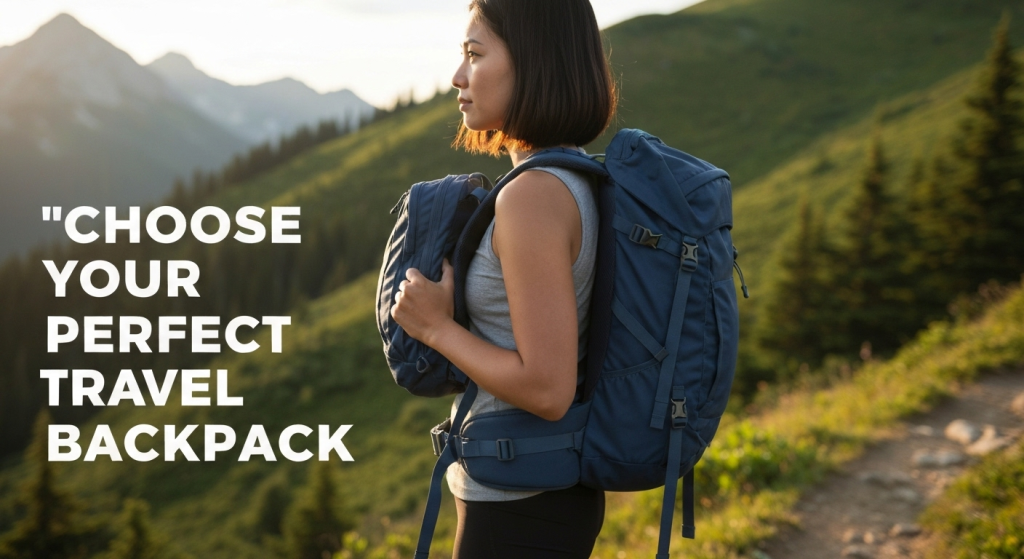
Choosing the right backpack forms the foundation of successful minimalist travel. Size, features, and build quality determine your entire packing strategy. After testing dozens of bags over five years, I’ve learned what truly matters.
The sweet spot for solo travel lies between 30-40 liters for most destinations. This capacity forces smart choices while providing adequate space for essentials. My current favorite is a 35-liter travel backpack with front-loading access and compression zippers.
Weight distribution makes a huge difference during long walking days. Look for padded shoulder straps, hip belts, and chest straps that distribute weight across your torso. The bag itself should weigh under 3 pounds when empty.
Durability matters more than fancy features. I’ve seen expensive bags fall apart after one month, while simple designs lasted years of heavy use. Focus on quality zippers, reinforced stress points, and water-resistant materials.
Key Features That Matter Most
- Front-loading access: Pack like a suitcase, not dig through from the top
- Compression straps: Reduce bulk when bag isn’t full
- Lockable zippers: Basic security for hostels and transit
- Padded laptop compartment: Protects electronics during rough handling
- External water bottle pocket: Easy access without opening main compartment
Clothing Strategy for 30-Day Travel
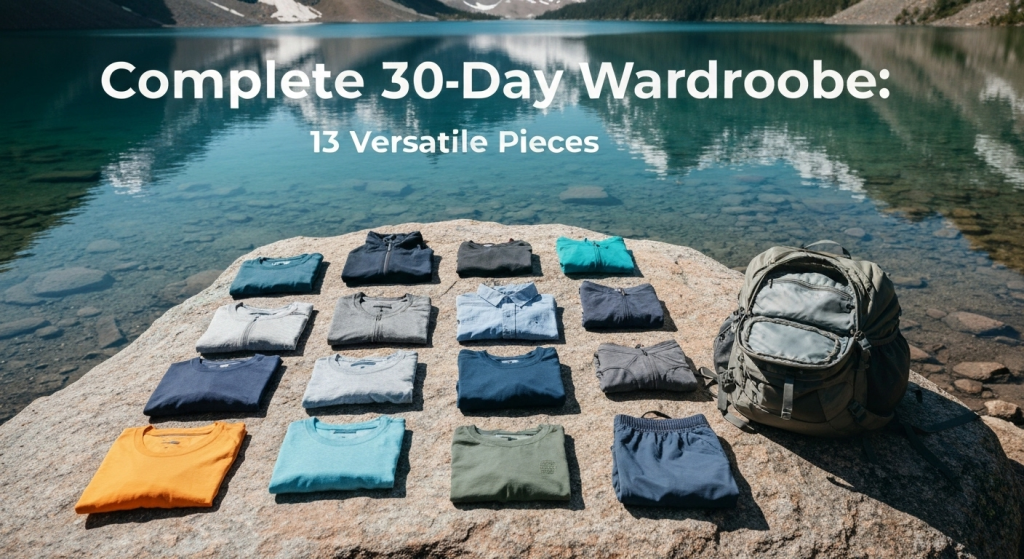
Smart clothing choices make or break minimalist travel experiences. The key lies in selecting versatile pieces that work across different climates, occasions, and activities. My clothing system revolves around layering, quick-dry materials, and neutral colors that mix and match easily.
For my Southeast Asia trip, I packed clothes for hot, humid weather with occasional air-conditioned spaces and mountain areas. The region’s climate variability required strategic choices that could adapt to temperature changes throughout each day.
My complete clothing list included seven tops, three bottoms, and strategic accessories. This combination provided fresh outfits daily while keeping laundry manageable. Quality fabrics that resist odors and wrinkles proved essential for maintaining a presentable appearance.
Complete Clothing Breakdown
Tops (7 items total):
- 3 merino wool t-shirts (odor-resistant, temperature regulating)
- 2 quick-dry synthetic shirts (lightweight, fast drying)
- 1 long-sleeve shirt (sun protection, air conditioning)
- 1 lightweight jacket (rain, wind, cool evenings)
Bottoms (3 items total):
- 1 pair travel pants (wrinkle-free, multiple pockets)
- 1 pair shorts (quick-dry, versatile length)
- 1 pair lightweight joggers (sleep, lounging, exercise)
Undergarments and Socks:
- 7 pairs merino wool underwear
- 5 pairs merino wool socks
- 2 bras (sports style for comfort and versatility)
Pros and Cons of Different Fabric Types
Merino Wool:
- Pros: Odor-resistant, temperature regulating, comfortable
- Cons: Expensive, requires careful washing, slower drying
Synthetic Blends:
- Pros: Quick-drying, affordable, durable
- Cons: Can retain odors, less comfortable in heat
Cotton:
- Pros: Comfortable, breathable, familiar
- Cons: Slow drying, wrinkles easily, heavy when wet
Technology and Electronics Essentials

Technology choices significantly impact both backpack weight and travel functionality. Modern travelers need connectivity, entertainment, and productivity tools while maintaining minimalist principles. My approach prioritizes multi-purpose devices that enhance rather than complicate the journey.
My electronics setup weighs just 2.5 pounds total but covers all essential needs. This weight includes backup power, connectivity solutions, and entertainment options for long transit days. Each device serves multiple purposes and justifies its space allocation.
Power management becomes crucial when traveling through areas with unreliable electricity. I learned this lesson the hard way during a three-day trek in remote Vietnam where my phone died on day one. Now I always carry adequate backup power and charging solutions.
My Complete Electronics Kit
Core Devices:
- iPhone 14 Pro (camera, communication, navigation, entertainment)
- MacBook Air M2 (work, entertainment, photo editing)
- AirPods Pro (music, calls, noise cancellation)
- Apple Watch (fitness tracking, notifications, backup alarm)
Power and Connectivity:
- 20,000mAh power bank (charges phone 4+ times)
- 65W GaN charger (fast charging for all devices)
- Universal adapter with USB ports
- Lightning and USB-C cables (one of each)
Accessories:
- Portable phone stand (video calls, entertainment)
- Cable organizer pouch (prevents tangling mess)
Power Bank Comparison Table
| Capacity | Weight | Phone Charges | Best For |
|---|---|---|---|
| 10,000mAh | 180g | 2-3 charges | Day trips |
| 20,000mAh | 350g | 4-5 charges | Multi-day adventures |
| 30,000mAh | 500g | 6-8 charges | Extended off-grid travel |
Personal Care and Health Items
Maintaining health and hygiene while traveling minimally requires strategic product choices and creative solutions. My personal care kit weighs under one pound but covers all essential needs for a month of travel. The focus remains on multi-purpose products and trial sizes that reduce bulk.
Toiletries represent one area where many travelers overpack significantly. I’ve seen people bring full-size bottles of products they rarely use at home. My approach centers on essentials that maintain health, comfort, and social acceptability without excess weight or space.
Climate considerations influence product selection heavily. Hot, humid environments require different solutions than cold, dry destinations. For Southeast Asia, I prioritized sun protection, insect repellent, and products that work well in high humidity conditions.
Essential Health and Hygiene Items
Daily Care:
- Travel toothbrush and toothpaste tablets
- Solid shampoo and conditioner bars
- Biodegradable soap (body and laundry)
- Deodorant (solid, aluminum-free)
- Sunscreen SPF 50 (face and body)
Health Essentials:
- First aid kit (bandages, antiseptic, pain relievers)
- Prescription medications (30-day supply plus extra)
- Probiotics (digestive health support)
- Electrolyte tablets (hydration support)
- Insect repellent (DEET-based for tropical areas)
Specialized Items:
- Quick-dry towel (microfiber, compact)
- Nail clippers and tweezers
- Contact lens supplies (if needed)
- Feminine hygiene products (menstrual cup recommended)
Benefits of Solid vs. Liquid Products
Solid products offer multiple advantages for minimalist travelers. They eliminate liquid restrictions during airport security, prevent messy spills in backpacks, and often last longer than liquid equivalents. My transition to solid toiletries reduced my personal care kit size by 40% while improving functionality.
Shampoo bars initially seemed gimmicky, but quality options clean effectively while lasting 2-3 months of regular use. Toothpaste tablets eliminate tubes that always seem to burst at inconvenient moments. Solid deodorant prevents airport confiscation and works reliably in hot climates.
Safety and Security Considerations
Travel safety extends beyond personal awareness to protecting your belongings and important documents. Minimalist travelers face unique challenges since losing items becomes more problematic when you have fewer backups. My security strategy balances protection with accessibility and weight considerations.
During five years of solo travel, I’ve encountered various security situations that taught valuable lessons about preparation and prevention. The key lies in making theft difficult while maintaining easy access to essentials during daily activities.
Document protection ranks as the highest priority for international travelers. Losing your passport in a foreign country creates massive complications that can ruin entire trips. I use a multi-layered approach that includes physical and digital backup systems.
Security Strategy Components
Document Protection:
- RFID-blocking passport holder
- Digital copies stored in cloud (Google Drive, Dropbox)
- Physical copies in separate bag compartment
- Emergency contact information list
Money Management:
- Primary credit card and backup card from different banks
- Small amount of cash in local currency
- Money belt for high-risk situations
- Digital payment apps (Apple Pay, Google Pay)
Bag Security:
- TSA-approved locks for hostel lockers
- Pacsafe cable lock for public spaces
- Hidden internal pocket for emergency cash
- Distinctive bag tags for easy identification
Common Security Mistakes to Avoid
Many travelers create unnecessary vulnerabilities through poor security habits. Keeping all money in one wallet, using easily guessed phone passwords, and leaving bags unattended in public spaces invite problems. These mistakes become more costly when you’re traveling with minimal backup resources.
The most effective security measures blend seamlessly into daily routines. Complicated systems that require constant attention often get abandoned when they become inconvenient. My approach focuses on simple habits that provide maximum protection with minimal effort.
Laundry and Maintenance Tips
Maintaining clean clothes and functional gear becomes essential when traveling with limited items. My laundry strategy ensures fresh clothing daily while minimizing time and resources spent on maintenance tasks. The approach works regardless of available facilities or local laundry costs.
Hand washing might seem primitive, but it offers complete control over timing and quality. I can wash clothes in any sink, shower, or clean water source without depending on finding laundromats or paying high hotel fees. This independence proves especially valuable in remote areas or budget accommodations.
Fabric choice dramatically impacts laundry success and drying times. Quick-dry synthetics and merino wool dry overnight in most conditions, while cotton items might stay damp for days in humid climates. This difference affects daily comfort and overall travel enjoyment.
Effective Hand Washing Technique
Step-by-Step Process:
- Fill sink with lukewarm water and biodegradable soap
- Soak items for 5-10 minutes to loosen dirt and oils
- Agitate gently, focusing on collar and underarm areas
- Rinse thoroughly with clean water until soap disappears
- Roll items in towel to remove excess water
- Hang in ventilated area away from direct sunlight
Drying Optimization:
- Use hangers when available for better air circulation
- Flip items every few hours for even drying
- Position near fans or open windows for faster results
- Pack slightly damp items if necessary (they’ll finish drying)
Laundry Supply Recommendations
| Item | Purpose | Weight | Notes |
|---|---|---|---|
| Biodegradable soap sheets | Washing clothes and body | 15g | TSA-friendly, multi-purpose |
| Sink stopper | Enable sink washing anywhere | 20g | Universal rubber type works best |
| Clothesline with clips | Hang items to dry | 50g | Adjustable length, strong clips |
| Quick-dry towel | Remove excess water | 150g | Microfiber, multiple sizes available |
Real-World Packing Experience
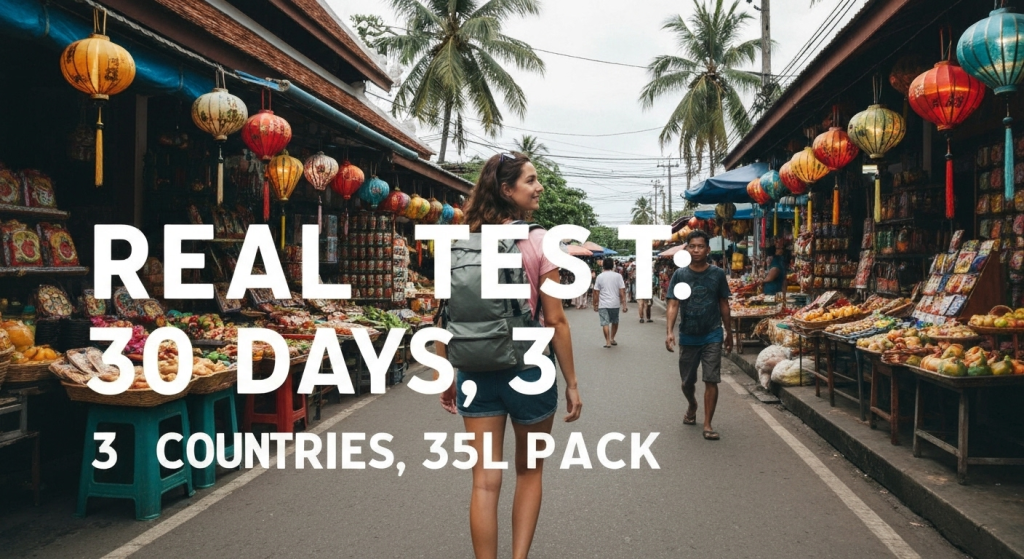
My recent month-long journey through Vietnam, Thailand, and Cambodia put this minimalist system to the ultimate test. The trip included everything from mountain trekking to beach relaxation, bustling cities to remote villages, and luxury resorts to basic hostels.
The first week proved challenging as I adjusted to having fewer clothing options and entertainment choices. By week two, the system felt natural and liberating. I spent less time deciding what to wear and more time exploring new places. The lightweight backpack made spontaneous adventures possible without physical strain.
Weather variations tested my clothing strategy extensively. Morning temperatures in Da Lat required long sleeves and pants, while afternoons in Bangkok demanded minimal coverage and maximum ventilation. The layering system handled these changes effectively without requiring additional items.
Unexpected Challenges and Solutions
Challenge: Laundry took longer to dry during rainy season Solution: Packed slightly damp items and used body heat for final drying
Challenge: Limited power outlets in budget accommodations
Solution: High-capacity power bank provided independence from wall charging
Challenge: Cultural dress codes at temples and formal restaurants Solution: Long-sleeve shirt and pants combination met all requirements
Challenge: Theft attempt at crowded market Solution: Money belt and hidden pockets kept valuables secure
Items I Wished I’d Packed
Despite careful planning, a few items would have improved the experience:
- Packable rain jacket (umbrella wasn’t always practical)
- Electrolyte powder (tablets took up less space but powder mixed better)
- Backup phone charger (my single cable showed wear after three weeks)
- Earplugs (noise levels varied dramatically between accommodations)
Cost Analysis and Budget Impact
Minimalist packing creates significant financial advantages beyond avoiding baggage fees. The approach reduces shopping temptation, simplifies transportation choices, and enables budget allocation toward experiences rather than possessions.
My total packing investment was approximately $1,200 for high-quality items designed to last multiple trips. This upfront cost pays dividends through durability, functionality, and travel convenience. Quality items perform better and require fewer replacements over time.
Baggage fee savings alone justified the investment during my first year of minimalist travel. Major airlines charge $30-60 per checked bag each direction, adding $120-240 to round-trip costs. Carry-on-only travel eliminates these fees while reducing check-in times and lost luggage risks.
Financial Impact Breakdown
One-Time Investment:
- Quality backpack: $200
- Minimalist wardrobe: $600
- Electronics and accessories: $300
- Travel gear and supplies: $100
- Total Initial Cost: $1,200
Per-Trip Savings:
- Baggage fees avoided: $120-240
- Reduced shopping impulse: $200-400
- Lower transportation costs: $50-100
- Average Trip Savings: $370-740
Return on Investment Timeline
| Trips Completed | Total Savings | ROI Status |
|---|---|---|
| 2 trips | $740-1,480 | Break-even point |
| 5 trips | $1,850-3,700 | 154% ROI minimum |
| 10 trips | $3,700-7,400 | 308% ROI minimum |
Environmental Impact Considerations
Minimalist travel aligns naturally with environmental consciousness and sustainable tourism practices. Reduced consumption, lighter transportation loads, and quality-over-quantity purchasing decisions create positive environmental impacts that extend beyond individual trips.
The fashion industry generates massive environmental waste through fast fashion and disposable clothing culture. My minimalist wardrobe focuses on high-quality items designed to last years rather than seasons. This approach reduces textile waste while supporting ethical manufacturing practices.
Transportation represents the largest environmental impact for most travelers. Minimalist packing enables public transportation use, walking, and cycling options that might be impractical with heavy luggage. These choices reduce carbon footprints while providing authentic local experiences.
Sustainable Travel Practices
Clothing Choices:
- Buy quality items that last multiple years
- Choose natural fibers like merino wool when possible
- Support ethical brands with transparent supply chains
- Repair items instead of replacing when feasible
Transportation Decisions:
- Use public transit enabled by light packing
- Walk more due to comfortable backpack weight
- Choose overland routes when practical
- Avoid unnecessary flights between nearby destinations
Frequently Asked Questions
What if I need formal clothes for special occasions?
Pack one versatile outfit that works for multiple formal situations. Dark jeans or travel pants with a collared shirt handle most requirements. Many destinations offer affordable clothing rentals for very formal events like weddings or business meetings.
How do you handle different climates in one trip?
Layering systems work better than packing for specific temperatures. Base layers, insulating pieces, and outer shells adapt to various conditions while taking minimal space. Research destination climates and pack for the most challenging conditions you’ll encounter.
What about souvenirs and shopping during travel?
Minimalist travel doesn’t prohibit buying items you truly value. Ship larger purchases home instead of carrying them. Focus on small, meaningful items that enhance your life rather than generic tourist merchandise that ends up forgotten.
How do you maintain hygiene with so few clothes?
Quality fabrics like merino wool resist odors naturally and can be worn multiple times between washes. Hand washing every 2-3 days keeps everything fresh. Solid toiletries work effectively while saving space and weight compared to liquid alternatives.
Conclusion
Minimalist backpack travel transformed my relationship with both possessions and experiences. The 30-day journey with just a 35-liter backpack proved that less truly enables more – more freedom, more spontaneity, and more meaningful connections with places and people.
The key to successful minimalist packing lies in intentional choices rather than arbitrary restrictions. Every item must earn its place through versatility, quality, and genuine necessity. This approach creates a travel system that enhances rather than complicates your adventures.
Start small with weekend trips to test your minimalist system before committing to longer journeys. Learn what works for your travel style, climate preferences, and comfort requirements. The skills develop over time through practice and refinement.
Remember that minimalist travel serves your goals, not the other way around. If an item significantly improves your experience, include it. The objective is intentional packing that supports amazing adventures, not suffering for the sake of carrying less weight.
Your journey toward minimalist travel begins with a single decision to prioritize experiences over possessions. Take that first step, and discover the freedom that comes with everything you need fitting perfectly on your back.

